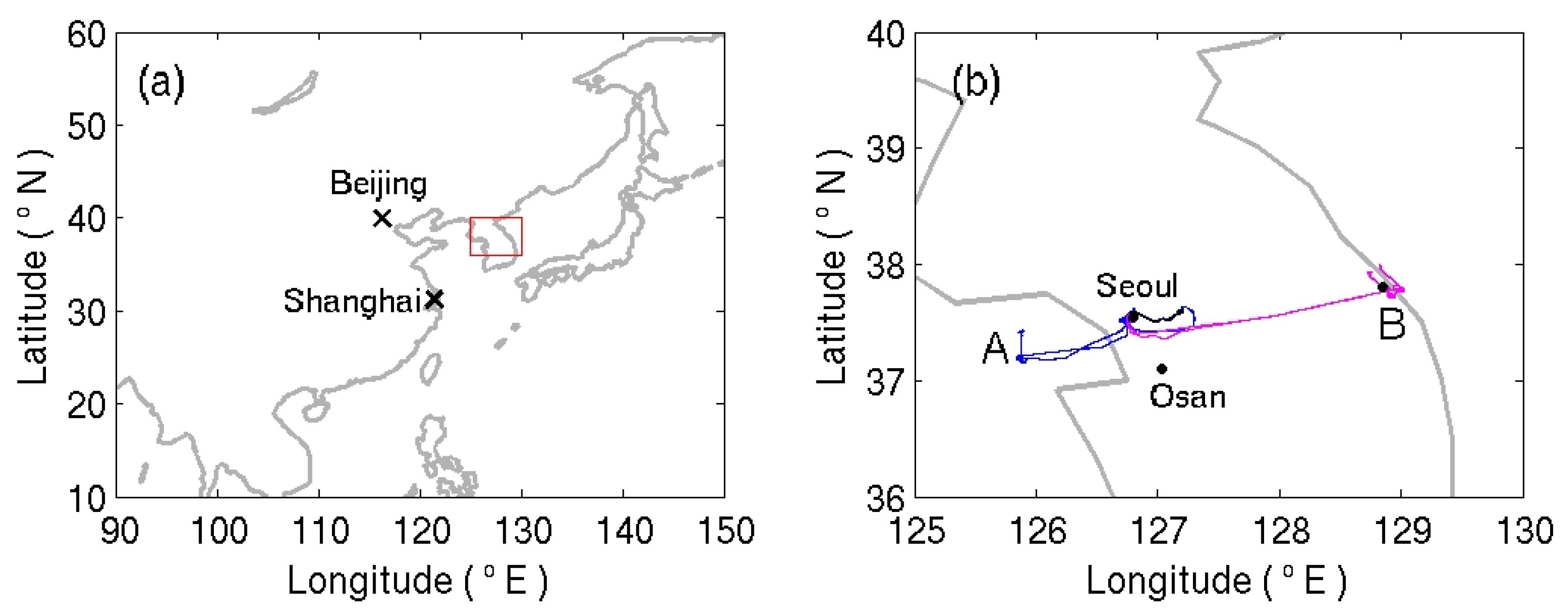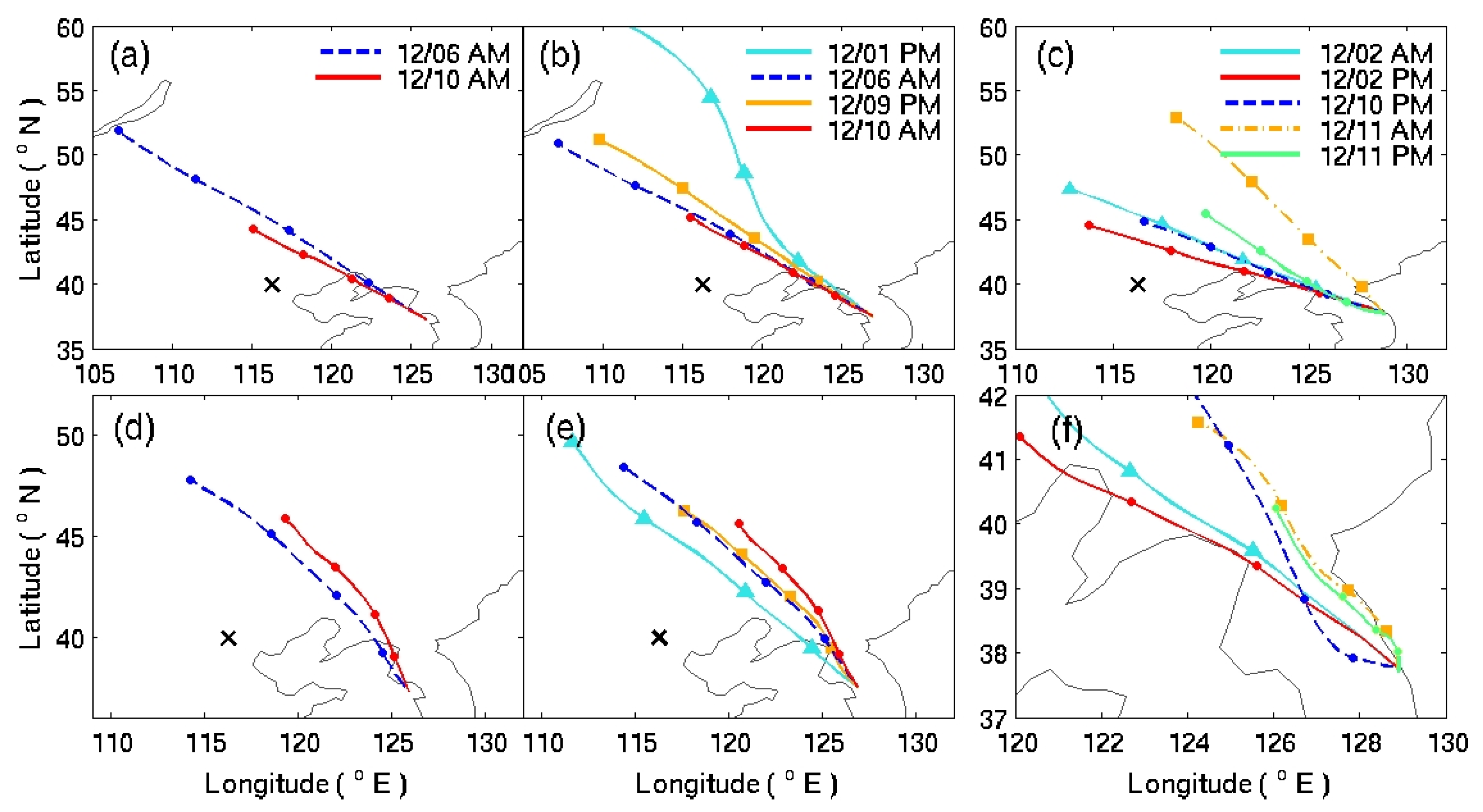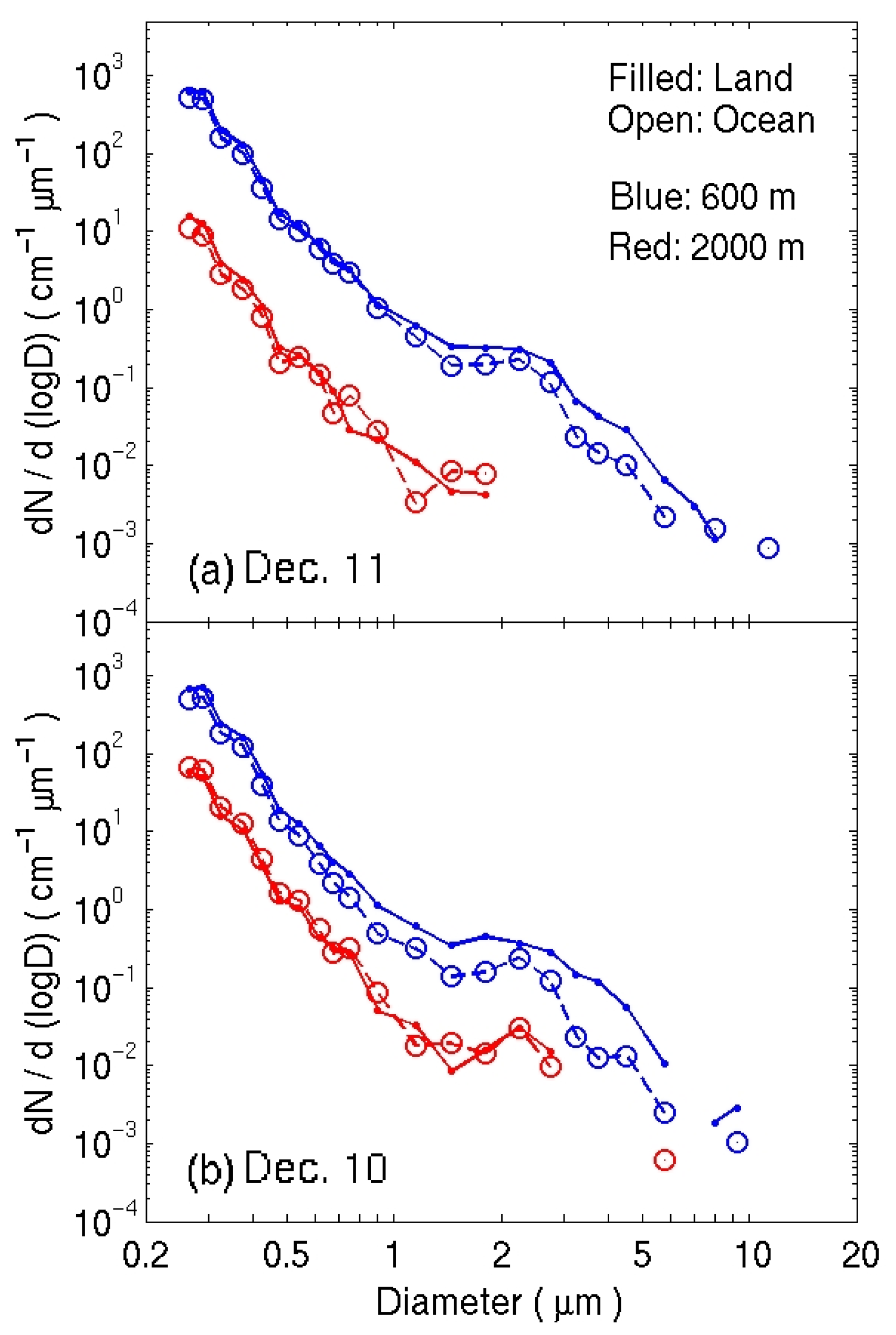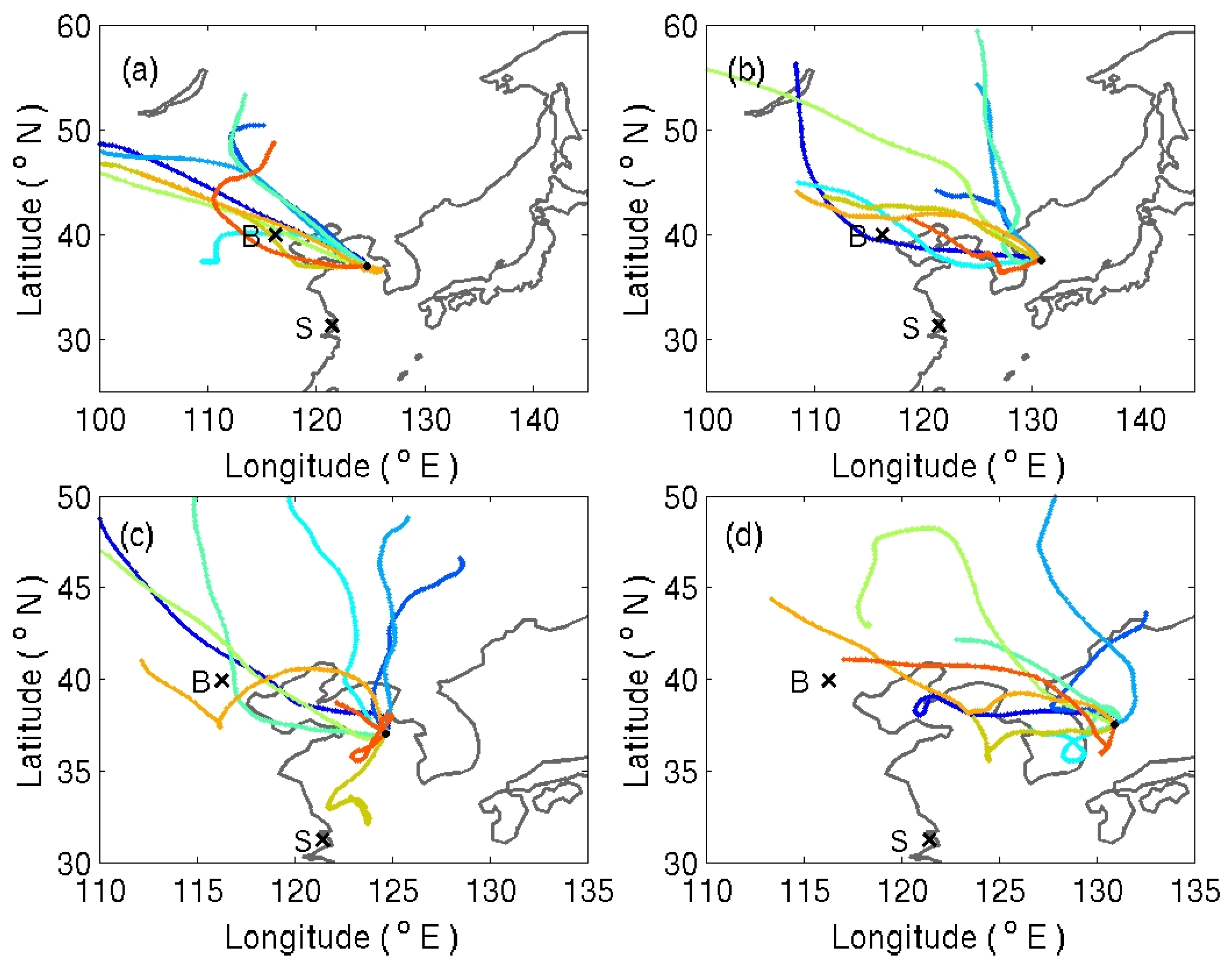Aerosol Properties within and above the Planetary Boundary Layer across the Korean Peninsula during December 2016
Abstract
1. Introduction
2. Data and Methods
3. Results
3.1. Back Trajectory
3.2. Vertical Structure of Aerosols
3.3. Particle Size Distribution
4. Discussion
5. Summary and Conclusions
Author Contributions
Funding
Institutional Review Board Statement
Informed Consent Statement
Acknowledgments
Conflicts of Interest
References
- Twomey, S. The influence of pollution on the shortwave albedo of clouds. J. Atmos. Sci. 1977, 34, 1149–1152. [Google Scholar] [CrossRef]
- Albrecht, B.A. Aerosols, cloud microphysics, and fractional cloudiness. Science 1989, 245, 1227–1230. [Google Scholar] [CrossRef]
- Anderson, T.; Charlson, R.; Bellouin, N.; Boucher, O.; Chin, M.; Christopher, S.; Haywood, J.; Kaufman, Y.J.; Kinne, S.; Ogren, J.A.; et al. An “A-Train” strategy for quantifying direct climate forcing by anthropogenic aerosols. Bull. Am. Meteorol. Soc. 2005, 86, 1795–1809. [Google Scholar] [CrossRef]
- Wild, M. Global dimming and brightening: Areview. J. Geophys. Res. Atmos. 2009, 114, D00d16. [Google Scholar] [CrossRef]
- IPCC. Climate Change 2013: The physical science basis. In Contribution of Working Group I to the Fifth Assessment Report of the Intergovernmental Panel on Climate Change; Stocker, T.F., Qin, D., Plattner, G.-K., Tignor, M., Allen, S.K., Boschung, J., Nauels, A., Xia, Y., Bex, V., Midgley, P.M., Eds.; Cambridge University Press: Cambridge, UK; New York, NY, USA, 2013; p. 1535. [Google Scholar] [CrossRef]
- Schwartz, S.E.; Charlson, R.J.; Kahn, R.A.; Ogren, J.A.; Rodhe, H. Why hasn’t earth warmed as much as expected? J. Clim. 2010, 23, 2453–2464. [Google Scholar] [CrossRef][Green Version]
- Ding, A.J.; Huang, X.; Nie, W.; Sun, J.N.; Kerminen, V.-M.; Petäjä, T.; Su, H.; Cheng, Y.F.; Yang, X.-Q.; Wang, M.H.; et al. Enhanced haze pollution by black carbon in megacities in China. Geophys. Res. Lett. 2016, 43, 2873–2879. [Google Scholar] [CrossRef]
- Prospero, J.M.; Collard, F.-X.; Molinie, J.; Jeannot, A. Characterizing the annual cycle of African dust transport to the Caribbean basin and South America and its impact on the environment and air quality. Glob. Biogeochem. Cycles 2014, 29, 757–773. [Google Scholar] [CrossRef]
- Holben, B.N.; Eck, T.F.; Slutsker, I.; Tanre’, D.; Buis, J.P.; Setzer, A.; Vermote, E.; Reagan, J.A.; Kaufman, Y.J.; Nakajima, T.; et al. AERONET—A federated instrument network and data archive for aerosol characterization. Rem. Sens. Environ. 1998, 66, 1–16. [Google Scholar] [CrossRef]
- Yum, S.S.; Hudson, J.G.; Song, K.Y.; Choi, B.-C. Springtime cloud condensation nuclei concentrations on the west coast of Korea. Geophys. Res. Lett. 2005, 32, L09814. [Google Scholar] [CrossRef]
- Nakajima, T.; Sekiguchi, M.; Takemura, T.; Uno, I.; Higurashi, A.; Kim, D.; Sohn, B.J.; Oh, S.-N.; Nakajima, T.Y.; Ohta, S.; et al. Significance of direct and indirect radiative forcings of aerosols in the East China Sea region. J. Geophys. Res. 2003, 108, 8658. [Google Scholar] [CrossRef]
- Wang, Z.; Wu, Z.; Yue, D.; Shang, D.; Guo, S.; Sun, J.; Ding, A.; Wang, L.; Jiang, J.; Guo, H.; et al. New particle formation in China: Current knowledge and further directions. Sci. Total. Environ. 2017, 577, 258–266. [Google Scholar] [CrossRef]
- Loeb, N.G.; Schuster, G.L. An observational study of the relationship between cloud, aerosol and meteorology in broken low level cloud conditions. J. Geophys. Res. 2008, 113, D14214. [Google Scholar] [CrossRef]
- Welton, E.J.; Voss, K.J.; Gordon, H.R.; Maring, H.; Smirnov, A.; Holben, B.; Schmid, B.; Livingston, J.M.; Durkee, P.A.; Formenti, P.; et al. Ground-based lidar measurements of aerosols during ACE-2: Instrument description, results, and comparisons with other ground-based and airborne measurements. Tellus 2000, 52B, 636–651. [Google Scholar] [CrossRef]
- Seinfeld, J.H.; Carmichael, G.R.; Arimoto, R.; Conant, W.C.; Brechtel, F.J.; Bates, T.S.; Cahill, T.A.; Clarke, A.D.; Doherty, S.J.; Flatau, P.J.; et al. ACE-Asia: Regional climatic and atmospheric chemical effects of Asian dust and pollution. Bull. Amer. Meteorol. Soc. 2004, 85, 367–380. [Google Scholar] [CrossRef]
- Jung, E.; Albrecht, B.A.; Prospero, J.M.; Jonsson, H.H.; Kreidenweis, S.M. Vertical structure of aerosols, temperature and moisture associated with an intense African dust event observed over the Eastern Caribbean. J. Geophys. Res. 2013, 118, 4623–4643. [Google Scholar] [CrossRef]
- Yum, S.S.; Roberts, G.; Kim, J.H.; Song, K.; Kim, D. Sub-micron aerosol size distributions and cloud condensation nuclei concentrations measured at Gosan, Korea, during the Atmospheric Brown Clouds-East Asian Regional Experiment 2005. J. Geophys. Res. 2007, 112, D22S32. [Google Scholar] [CrossRef]
- Kim, J.H.; Yum, S.S.; Shim, S.; Yoon, S.-C.; Hudson, J.G.; Park, J.; Lee, S.-J. On aerosol hygroscopicity, cloud condensation nuclei (CCN) spectra and critical supersaturation measured at two remote islands of Korea between 2006 and 2009. Atmos. Chem. Phys. 2011, 11, 12627–12645. [Google Scholar] [CrossRef]
- Kim, J.H.; Yum, S.S.; Shim, S.; Kim, W.J.; Park, M.; Kim, J.-H.; Kim, M.-H.; Yoon, S.-C. On the submicron aerosol distributions and CCN number concentrations in and around the Korean Peninsula. Atmos. Chem. Phys. 2014, 14, 8763–8779. [Google Scholar] [CrossRef]
- Kim, J.H.; Yum, S.S.; Lee, Y.-G.; Choi, B.-C. Ship measurements of submicron aerosol size distributions over the Yellow Sea and the East China Sea. Atmos. Res. 2009, 93, 700–714. [Google Scholar] [CrossRef]
- Kim, Y.J.; Lee, J.H.; Kim, B.-G. An analysis of aerosol-cloud relationship using MODIS and NCEP/NCAR reanalysis data around Korea. J. Korean Soc. Atmos. Environ. 2011, 27, 152–167. (in Korean). [Google Scholar] [CrossRef]
- Kim, M.-H.; Yeo, H.; Sugimoto, N.; Lim, H.-C.; Lee, C.-K.; Heo, B.-H.; Yu, Y.-S.; Sohn, B.-J.; Yoon, S.-C.; Kim, S.-W. Estimation of particle mass concentration from lidar measurement. Atmosphere 2015, 25, 169–177. (in Korean). [Google Scholar] [CrossRef]
- Huebert, B.J.; Bates, T.; Russell, P.B.; Shi, G.; Kim, Y.J.; Kawamura, K.; Carmichael, G.; Nakajima, T. An overview of ACE-Asia: Strategies for quantifying the relationships between Asian aerosols and their climatic impacts. J. Geophys. Res. 2003, 108, 8633. [Google Scholar] [CrossRef]
- Clarke, A.; Kapustin, V. Hemispheric aerosol vertical profiles: Anthropogenic impacts on optical depth and cloud nuclei. Science 2010, 329, 1488–1492. [Google Scholar] [CrossRef] [PubMed]
- Stull, R.B. An Introduction to Boundary Layer Meteorology; Kluwer Academic: Norwell, MA, USA, 1988; 666p. [Google Scholar]
- Rogers, R.R.; Yau, M.K. A Short Course in Cloud Physics, 3rd ed.; International Series in Natural Philosophy: Oxford, UK, 1989; 290p. [Google Scholar]
- Shi, H.; Lee, S.S.; Chun, H.W.; Song, H.J.; Noh, Y.C.; Sohn, B.J. Optical properties of aerosols related to haze events over Seoul inferred from Skyradiometer and satellite-borne measurements. Atmosphere 2016, 26, 289–299. [Google Scholar] [CrossRef]
- Chun, Y.; Kim, J.; Choi, J.-C.; Shin, D.-S. The Characteristics of the Aerosol Number Concentration Observed in Seoul and Anmyondo During an Yellow Sand Phenomenon. J. KOSAE 1999, 15, 575–586. [Google Scholar]
- Guo, S.; Hu, M.; Zamora, M.L.; Peng, J.; Shang, D.; Zheng, J.; Du, Z.; Wu, Z.; Shao, M.; Zeng, L.; et al. Elucidating severe urban haze formation in China. Proc. Natl. Acad. Sci. USA 2014, 111, 17373–17378. [Google Scholar] [CrossRef] [PubMed]
- Jung, E.; Albrecht, B.A.; Feingold, G.; Jonsson, H.H.; Chuang, P.; Donaher, S.L. Aerosols, clouds, and precipitation in the North Atlantic trades observed during the Barbados aerosol cloud experiment—Part 1: Distributions and variability. Atmos. Chem. Phys. 2016, 16, 8643–8666. [Google Scholar] [CrossRef]







| RF No. | Date | Time (LST) HH:MM | Main Flight Area | Path No. | Note |
|---|---|---|---|---|---|
| 1 | 1 December 2016 | 15:13–16:32 | Seoul | 3 | Two layers along the Han River Flight was made across the coastline |
| 2 | 2 December 2016 | 09:36–12:44 | Gangneung | 1 | Flight was made across the coastline |
| 3 | 2 December 2016 | 13:51–18:13 | Gangneung | 1 | RF was made along the Han River (the lowest level only), then flew to the Gangneung area (across the coastline) |
| 4 | 6 December 2016 | 7:47–11:35 | Yellow Sea, Seoul | 3 | Three layers along the Han River |
| 5 | 9 December 2016 | 14:22–16:12 | Seoul | 3 | Three layers along the Han River |
| 6 | 10 December 2016 | 7:56–11:37 | Yellow Sea, Seoul | 3 | Three layers along the Han River |
| 7 | 10 December 2016 | 13:37–16:21 | Gangneung | 2 | RF was made along the Han River (the lowest level), then flew to the Gangneung area (parallel to the coastline) |
| 8 | 11 December 2016 | 7:45–11:22 | Gangneung | 2 | RF was made along the Han River (the lowest level), then flew to the Gangneung area (parallel to the coastline) |
| 9 | 11 December 2016 | 12:51–16:39 | Gangneung | 2 | Parallel to the coastline |
| Location | Figure 4 (Colors) | Date | Height (m) | NCN (cm−3) | PM10 (μg m−3) | |
|---|---|---|---|---|---|---|
| Yellow Sea | (a) and (e) | blue dashed | 6 December AM | 661.2 ± 966.2 | 1143.1 ± 642.8 | 6.37 ± 2.34 |
| 1903.0 ± 76.75 | 85.6 ± 12.12 | 0.49 ± 0.14 | ||||
| red solid | 10 December AM | 431.6 ± 6.08 | 288.2 ± 103.89 | 8.51 ± 3.52 | ||
| 1866.5 ± 8.07 | 299.88 ± 356.03 | 0.42 ± 0.08 | ||||
| Seoul | (b) and (f) | sky solid | 1 December PM | 738.8 ± 19.8 | 7773.0 ± 770.8 | 14.6 ± 3.16 |
| 1738.1 ± 14.1 | 2935.4 ± 1872.6 | 6.01 ± 3.33 | ||||
| blue dashed | 6 December AM | 406.8 ± 465.96 | 5335.1 ± 752.9 | 16.27 ± 3.90 | ||
| 1413.1 ± 29.62 | 77.2 ± 18.39 | 0.86 ± 0.79 | ||||
| 2363.5 ± 10.77 | 96.7 ± 8.71 | 0.13 ± 0.08 | ||||
| cooper solid | 9 December PM | 722.8 ± 10.39 | 2785.7 ± 693.4 | 25.69 ± 4.28 | ||
| 1454.2 ± 13.56 | 299.6 ± 252.4 | 2.35 ± 2.69 | ||||
| 2384.4 ± 19.42 | 76.6 ± 12.10 | 0.95 ± 0.19 | ||||
| red solid | 10 December AM | 708.4 ± 47.28 | 1231.3 ± 1089.4 | 7.35 ± 5.37 | ||
| 1428.5 ± 9.19 | 457.8 ± 24.3 | 0.60 ± 0.13 | ||||
| 2359.0 ± 6.72 | 387.6 ± 22.8 | 0.11 ± 0.03 | ||||
| grey | 2 December PM | 721.8 ± 9.33 | 5498.3 ± 1507.0 | 14.83 ± 3.27 | ||
| grey | 10 December PM | 707.5 ± 8.39 | 4313.3 ± 2410.4 | 19.5 ± 13.37 | ||
| grey | 11 December AM | 718.6 ± 21.47 | 464.98 ± 97.0 | 3.60 ± 0.73 | ||
| Gangneung | (c) and (g) | blue dashed dot | 10 December PM | 427.5 ± 7.03 | 3926.7 ± 545.0 | 9.9 ± 2.03 |
| 1910.3 ± 8.87 | 243.7 ± 109.14 | 0.68 ± 0.55 | ||||
| cooper | 11 December AM | 595.8 ± 9.50 | 862.85 ± 50.66 | 6.41 ± 1.02 | ||
| 1909.4 ± 5.41 | 141.15 ± 377.4 | 0.07 ± 0.10 | ||||
| green | 11 December PM | 580.4 ± 9.73 | 5084.6 ± 381.64 | 8.245 ± 1.46 | ||
| 1937.5 ± 9.98 | 136.2 ± 21.27 | 0.16 ± 0.08 | ||||
| East Sea | (d) and (h) | blue dashed dot | 10 December PM | 426.4 ± 8.18 | 1581.7 ± 620.72 | 6.33 ± 1.32 |
| 1906.9 ± 11.53 | 306.98 ± 150.51 | 0.77 ± 0.72 | ||||
| green dot | 11 December PM | 607.4 ± 430.59 | 2446.0 ± 430.60 | 6.45 ± 1.27 | ||
Publisher’s Note: MDPI stays neutral with regard to jurisdictional claims in published maps and institutional affiliations. |
© 2021 by the authors. Licensee MDPI, Basel, Switzerland. This article is an open access article distributed under the terms and conditions of the Creative Commons Attribution (CC BY) license (https://creativecommons.org/licenses/by/4.0/).
Share and Cite
Jung, E.; Seo, S.; Chang, K.-H.; Yum, S.-S.; Heo, B.-H. Aerosol Properties within and above the Planetary Boundary Layer across the Korean Peninsula during December 2016. Atmosphere 2021, 12, 1299. https://doi.org/10.3390/atmos12101299
Jung E, Seo S, Chang K-H, Yum S-S, Heo B-H. Aerosol Properties within and above the Planetary Boundary Layer across the Korean Peninsula during December 2016. Atmosphere. 2021; 12(10):1299. https://doi.org/10.3390/atmos12101299
Chicago/Turabian StyleJung, Eunsil, Seongkyu Seo, Ki-Ho Chang, Seong-Soo Yum, and Bok-Haeng Heo. 2021. "Aerosol Properties within and above the Planetary Boundary Layer across the Korean Peninsula during December 2016" Atmosphere 12, no. 10: 1299. https://doi.org/10.3390/atmos12101299
APA StyleJung, E., Seo, S., Chang, K.-H., Yum, S.-S., & Heo, B.-H. (2021). Aerosol Properties within and above the Planetary Boundary Layer across the Korean Peninsula during December 2016. Atmosphere, 12(10), 1299. https://doi.org/10.3390/atmos12101299







